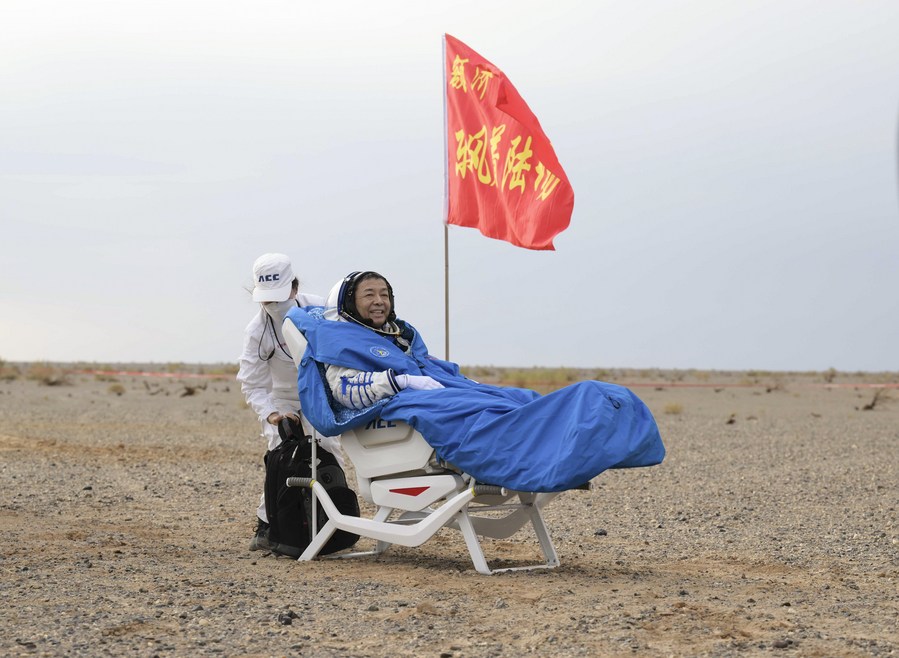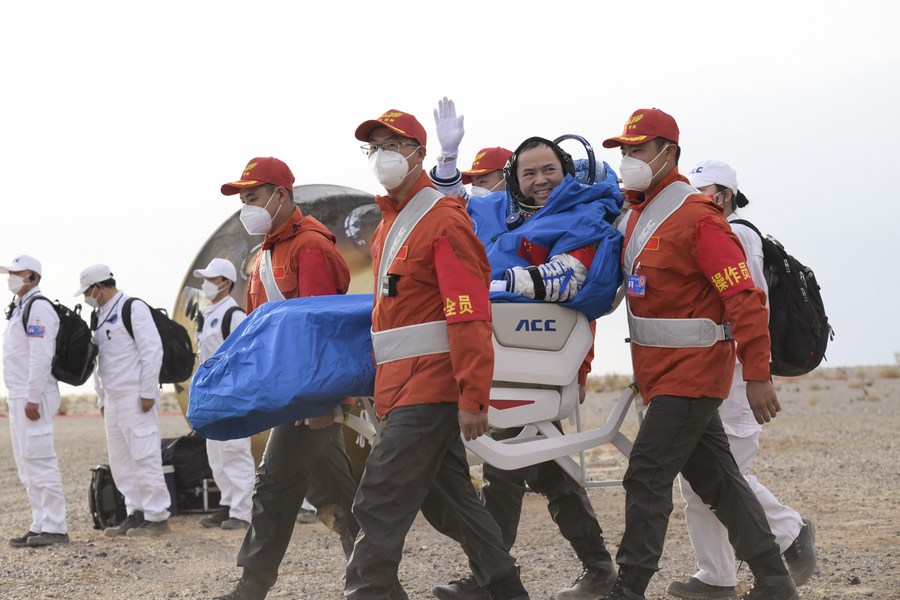* Three Chinese astronauts on board Shenzhou-15 manned spaceship returned safely Sunday after six-month space station mission.
* The crew successfully completed four extravehicular activities (EVAs).
* The crew lived and worked in the space station complex for 186 days.
JIUQUAN, June 4 (Xinhua) -- Three Chinese astronauts on board the Shenzhou-15 manned spaceship returned to Earth safely on Sunday, after completing their six-month space station mission.
Shenzhou-15's return capsule, carrying astronauts Fei Junlong, Deng Qingming and Zhang Lu, touched down at the Dongfeng landing site in north China's Inner Mongolia Autonomous Region at 6:33 a.m. (Beijing Time), according to the China Manned Space Agency (CMSA).

The return capsule of the Shenzhou-15 manned spaceship touches down safely at the Dongfeng landing site in north China's Inner Mongolia Autonomous Region June 4, 2023. (Xinhua/Lian Zhen)
The astronauts were in good shape, and the Shenzhou-15 manned mission was a success, the agency announced.
The astronauts were carried out by ground workers and placed on chairs in front of the capsule.

Astronaut Fei Junlong is out of the return capsule of the Shenzhou-15 manned spaceship at the Dongfeng landing site in north China's Inner Mongolia Autonomous Region June 4, 2023. (Xinhua/He Shuchen)
"We have completed all the scheduled tasks and felt good after returning to the motherland," said Fei, the mission commander, who had also participated in the country's second crewed space mission, Shenzhou-6, in October 2005.
Deng, who finally got the chance to fly to space after 25 years of preparation, said that he is grateful for the support and encouragement of the people of the whole country.

Astronaut Deng Qingming is out of the return capsule of the Shenzhou-15 manned spaceship at the Dongfeng landing site in north China's Inner Mongolia Autonomous Region June 4, 2023. (Xinhua/Li Zhipeng)
"I always believe in the power of dreams and persistence. No matter how old I am, I feel so happy to be needed by the nation," he added.
"I'm now very excited, and when I was on the space station, I often watched through the window, trying to find my motherland and hometown," said Zhang, one of China's second batch of astronauts.

Astronaut Zhang Lu is out of the return capsule of the Shenzhou-15 manned spaceship at the Dongfeng landing site in north China's Inner Mongolia Autonomous Region June 4, 2023. (Xinhua/Li Zhipeng)
"We will adjust our bodies as soon as possible, go back into training, and be ready for space missions in the future," Zhang added.
The return capsule separated from Shenzhou-15's orbiting capsule at 5:42 a.m. as per the flight procedure.
Soon after the return capsule landed, the ground search team arrived at the landing site. Medical personnel confirmed that the astronauts were in good health.
China launched the manned spaceship Shenzhou-15 on Nov. 29, 2022. The Shenzhou-15 crew, China's oldest mission crew in terms of average age, successfully completed four extravehicular activities (EVAs), becoming the crew to accomplish the most EVAs of all Chinese crews to date.

This screen image captured at Beijing Aerospace Control Center on April 15, 2023 shows Shenzhou-15 taikonaut Zhang Lu waving after performing extravehicular activities outside the Wentian lab module. (Xinhua/Guo Zhongzheng)
The crew lived and worked in the space station complex for 186 days and conducted a number of experiments which produced fruitful results.
The crew successfully obtained three-dimensional structural images of their skin cells with the country's self-developed two-photon microscope.
This achievement, the first of its kind worldwide, marked the success of the in-orbit verification experiments of the two-photon microscope, providing a promising tool for future health monitoring of astronauts in orbit.
China also successfully performed the first in-orbit ignition test in the Mengtian space lab module's combustion cabinet during the Shenzhou-15 mission.
The test verified the functions of the combustion science experimental system of the space station and the accuracy and scientificity of the overall experimental process.
In addition, it is worth mentioning that the operation of the country's Stirling thermoelectric convertor realized its in-orbit verification. The heat-to-electricity convertor showed an internationally advanced conversion efficiency during its smooth operation, according to the CMSA.
China also completed in-orbit experiments on liquid metal thermal management on its space station for the first time ever during the Shenzhou-15 mission.
These experiments verified a series of key technologies concerning bismuth-based metal in microgravity, such as controlled melting, expansion and convection heat transfer.
As of May 29, they had conducted eight human factors engineering research activities, 28 space medical experiments and 38 space science experiments covering life ecology, material science and fluid mechanics, and obtained valuable experimental data.
The crew also moved cargo outboard several times and installed several items of equipment, including extravehicular extended pump sets, cross-module cables, and supporting devices for the extravehicular payload platform, laying a foundation for carrying out subsequent large-scale science and technology experiments outside the space station, according to the CMSA.
The crew witnessed the completion of the country's space station construction.





